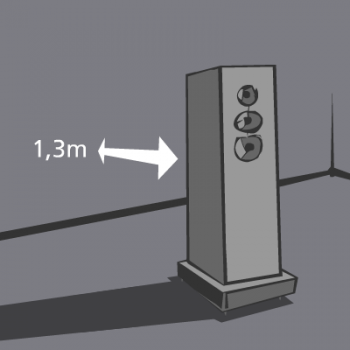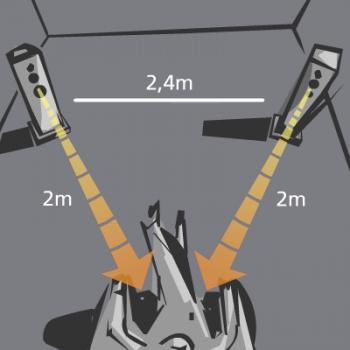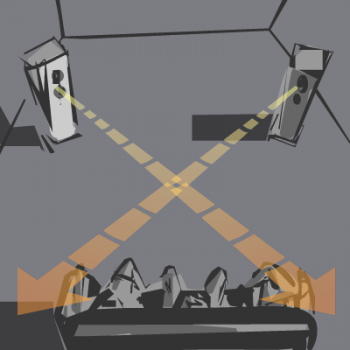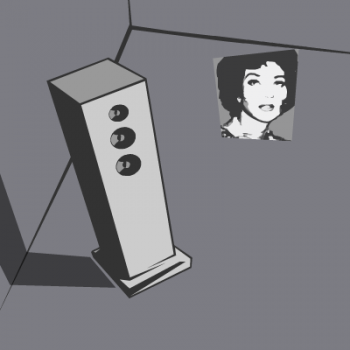Step 1
The speakers are set up 1.3 m (4.3 ft) away from the back wall of the listening room, because our example listener wants to ensure good bass performance.
After so much theory we are pleased to give you a practical example.

The speakers are set up 1.3 m (4.3 ft) away from the back wall of the listening room, because our example listener wants to ensure good bass performance.
The best sound balance can be achieved, if the speakers are placed half a meter away from the wall.






Our example listener truly is a perfectionist. After having determined the exact point of acoustic reflections on the side walls with the help of a mirror, he has placed diffusers (book shelves or other dampening objects) on the walls in order to suppress interfering reflections.
In our example the speakers are spaced 2.4 m (7.9 ft) away from each other and the optimal distance between speaker and the listener’s head is 2 m (6.6 ft). The aim is to reduce the effects of the room to a minimum and to ensure a wide soundstage.



These are the basic rules to create perfect listening conditions. Even your friends and family can share the acoustic pleasure, and they will feel like they are sitting in the 20th row of the concert hall instead of sitting in the 10th row, which is usually preferred by opera directors and music critics.
Once you have homed in on the right place, you should start to fine-tune the position of the loudspeakers. If you angle the speakers, you will roughly influence the balance of high frequencies (due to the directivity characteristic) and the spatial bass performance at the outer edges of the soundstage (due to the influence of inevitable reflections at the cabinet corner of the speaker). Generally speaking, the more the speakers point towards your ears, the more pronounced high frequency response you can achieve. However, in the case of quality loudspeakers this influence is very small.
At Audio Physic we have designed our speakers in such a way that the influence of corner reflections is less pronounced, if you can see only a small part of the inner side of the cabinet from your listening position.



If several people join you for a listening session, we recommend that you move the speakers so that their axes cross each other in front of the listening position.
In order to get the one so-called “sweet spot”, the axes should cross each other behind the listening seat. The further away the axes cross each other behind the listening seat, the wider the spatial soundstage becomes. However, you should bear in mind that moving the cross point of the axes too far behind the seat can result in a total loss of focus. In this case, you must compromise – just like in real life.






Once the set up is correct, you can concentrate on placing the speakers symmetrically around the listening seat in order to achieve a dimensional correct focus in the centre. Some positional experimentation should be done at this point. We recommend that you listen to a record with dimensional information (e.g. Maria Callas in “Aida” or Nancy Sinatra on “Boots”, track no. 15) and that you start moving the speakers backwards and forwards until the sound impression is more or less in the centre.
After having centered the image, you can tilt the speakers carefully around one point to get the best focus.



We have just finished our step-by-step instructions. Now you can relax and enjoy ideal soundstaging and superb sound performance: you will be amazed at how much of the music and how little of the room is heard.
– Position Example –